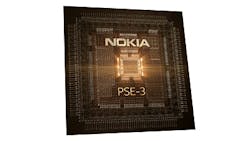Nokia touts ultimate in spectral efficiency via PSE-3 chipset and probabilistic constellation shaping
Nokia has unveiled what a company source described as possibly "the final piece of the puzzle when we talk about coherent transmission." The company says the Photonic Service Engine 3 (PSE-3) coherent chipset provides the ultimate in spectral efficiency thanks to its use of a digital signal processing (DSP) technology called probabilistic constellation shaping. The technique, paired in the PSE-3 with 64-QAM modulation, can increase fiber capacity by as much as 65% over current deployments, Nokia asserts.
The company has been working on the technology for some time, with an emphasis on optical networks over the past two or three years, reported Kyle Hollasch, director of product marketing, optical networking, at Nokia. As described in a series of papers and announcements (see "Probabilistic constellation shaping yields terabit transmission" and "Alcatel-Lucent Submarine Networks, Nokia Bell Labs report 65-Tbps transmission via probabilistic constellation shaping" as examples), probabilistic constellation shaping varies the use of individual points within, in this instance, a 64-QAM constellation depending upon the characteristics of the fiber and shapes the distribution of the symbols accordingly. Optical power is thus optimized for the fiber and application, enabling a more robust, spectrally efficient coherent transmission. A closed loop optimization function determines the fiber characteristics to help set the shaping parameters. (More details can be found via this video.)
The technique works so well that Hollasch theorized that Nokia's PSE-3 may get coherent optical transmission as close to the Shannon Limit (the theoretical maximum capacity of optical fiber) as the industry is likely to get. Individual wavelengths in future may exceed the current 600-Gbps maximum the PSE-3 supports, but the overall transmission is unlikely to be significantly more spectrally efficient, he said.
The efficiency the PSE-3 provides extends beyond spectrum use. The chipset uses probabilistically shaped 64-QAM for all transmission rates between 100 and 600 Gbps, which Hollasch pointed out reduces complexity and enables finergrain programmability. The channel size and baud rate remain consistent across transmission rates and applications as well. Power per bit can decline by as much as 60%, Hollasch added. The technique can be applied across a variety of fiber types.
As was the case with the PSE-2, Nokia will deploy two variants of the PSE-3 – super-coherent (PSE-3s) and compact (PSE-3c). Between the two, the PSE-3 will enable a variety of optimized transmission rate and distance pairings:
- 200 Gbps at ultra-long-haul and submarine network distances of approximately 2500 km
- 300 to 400 Gbps at regional network distances
- 500 to 600 Gbps at metro network distances.
The PSE-3 will support two channels of 600 Gbps per fiber, providing a maximum per-fiber capacity of 1.2 Tbps.
Nokia plans to roll out the PSE-3 across its packet-optical platform line, including an upcoming new version of the 1830 Photonic Service Interconnect platform called the PSI-M. The PSE-3c will begin deployments in the middle of this year, while the PSE-3s will debut toward the end of this year and into 2019, Hollasch said. It appears that networks are already being built with probabalistic constellation shaping in mind (see "Hong Kong-Americas submarine cable system swells transpacific deployment trend").
The PSE-3 was named a finalist in this year's Lightwave Innovation Reviews. Winners of the Reviews will be announced March 14.
For related articles, visit the Optical Technologies Topic Center.
For more information on high-speed transmission systems and suppliers, visit the Lightwave Buyer's Guide.

Stephen Hardy | Editorial Director and Associate Publisher
Stephen Hardy has covered fiber optics for more than 15 years, and communications and technology for more than 30 years. He is responsible for establishing and executing Lightwave's editorial strategy across its digital magazine, website, newsletters, research and other information products. He has won multiple awards for his writing.
Contact Stephen to discuss:
- Contributing editorial material to the Web site or digital magazine
- The direction of a digital magazine issue, staff-written article, or event
- Lightwave editorial attendance at industry events
- Arranging a visit to Lightwave's offices
- Coverage of announcements
- General questions of an editorial nature
